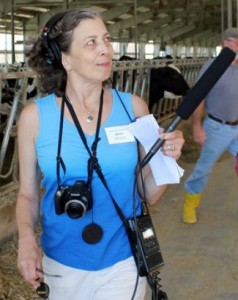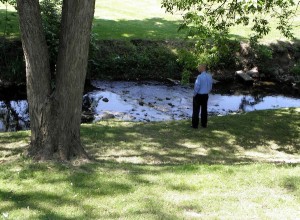
Mallard ducks will have a new home in a wetland designed to slow storm water. Photo: Karen Schaefer
Listen to the story here…

Karen Schaefer is an Ohio freelance journalist and independent radio producer.
Or follow the script:
By Karen Schaefer
ANCHOR INTRO: It’s all too common these days – there’s a flooded highway underpass on your way to work or your neighbor’s basement is inundated after a heavy rain. With more frequent and heavier storms, many Great Lakes cities are struggling with storm water. But as independent producer Karen Schaefer reports, in Northeast Ohio, a sewer district, a big-city suburb and a local watershed group are finding ways to better manage storm water, with the help of a little green space.
AMBI: Sound of rain on leaves, under:
SCHAEFER: It all starts with rain. On a wooded lot, rain patters off the leaves and is soaked up by trees thirsty for moisture. Excess water finds its way to the nearest creek, which swells and floods, then gradually soaks into nearby wetlands. Anyway that’s the plan nature intended.
AMBI: Sound of water going down storm drain, traffic, fade out under:
SCHAEFER: But in cities, with their miles of roads and acres of roof-tops and parking lots, storm water takes a different course. Storm drains carry away the water — and pollution – shed by all those hard surfaces. And when a storm is heavy, it can overload not only the sewers, but the small streams that run through many urban neighborhoods.
BOB GARDIN: For any given stream, what happens is that, instead of having that consistent ground flow into the stream, you have flash flooding.
SCHAEFER: That’s Bob Gardin, project manager for Friends of Big Creek, a watershed planning group he founded in 2004. Big Creek is the third largest tributary of the Cuyahoga River. Into it runs Stickney Creek. In the Cleveland suburb of Brooklyn, Gardin is walking through a neighborhood pocket of grassy, urban green space, toward this small stream.
AMBI: Sound of walking, fade up under above graph:
GARDIN: They mow all this grass, when in fact along the creek itself we prefer to see a buffer. You can see the kind of erosion it’s causing, by mowing to the edge, because we don’t have those deep roots holding in the soil.
AMBI: Sound of Stickney Creek, fade out under:
SCHAEFER: Gardin points to the tangled roots of some big trees along the stream, now bared by erosion. He says he and the local landowner would like to create a nature trail along a more naturalized stream. New wetland plants would help channel storm water away from the surrounding subdivision, which is prone to flooding. There’s no money yet for this project, but there are funds available from a new program at the Northeast Ohio Regional Sewer District for small neighborhood projects like this one that could help control storm water. The Sewer District’s Matt Scharver says over the last few years, there’s been a revolution in storm water management, something he calls green infrastructure.

Matt Scharver of the local sewer district says green infrastructure can help reduce neighborhood flooding. Photo: Karen Schaefer
SCHARVER: We’re truly focused on the green projects, better storm water management, innovative techniques. So we’re really hoping that this program pushes us forward, moving away from the pipe and pond engineered projects of the past.
SCHAEFER: Scharver says for bigger green storm water projects that impact more than one community, there’s a pot of about 35-Million dollars, to be spread over several years, collected from new storm water fees charged to homeowners and businesses. At the Fern Hill Picnic Area in the Big Creek Reservation in the Cleveland Metroparks, one such project is already underway.
AMBI: Sound of ducks, fade under, run park ambi, under:
SCHAEFER: In the neighboring Big Creek community of Parma, a 150-thousand dollar project will divert storm water from a 36-inch pipe into a constructed wetland to slow the water and filter out pollutants. The money for this project has another new source — the Ohio EPA’s Surface Water Improvement Fund, now in its third year. The new wetland will not only provide a home to visiting mallard ducks, it will divert storm water from 50-acres of residential neighborhood. Cleveland Metropark’s Jim Kastelic will manage the project. He says the new wetland will have big benefits for the nearby Cleveland Metropark Zoo.

Tree roots are bared by erosion, just one problem green infrastructure can fix. Photo: Karen Schaefer
Kastelic: We wind up with a lot of storm water at the Zoo from the Big Creek watershed. And we’ve had major floods over the last few years that have created some major economic issues for us.
SCHAEFER: This new wetland won’t be able to handle the volume of water produced by an intense or prolonged storm. So the Sewer District’s Matt Scharver says green infrastructure like this can’t replace the engineered storm water solutions – like massive tunnels – the agency is now constructing as part of its 3-Billion dollar project to prevent sewer overflows. But Scharver says these small green projects can make a big difference to neighborhood flooding – and still be cost-effective.
SCHARVER: Other parts of the country are out ahead of us on this, so we’re taking the lessons learned from them and applying them to Northeast Ohio, so that we can best utilize those dollars that we’re generating through the regional program.
SCHAEFER: Scharver hopes other Ohio communities will take a look at what’s happening in Big Creek and come up with their own plans to keep local flood waters at bay. It’s too early yet to be sure how effective these projects will be, but in cities like Toledo, they’ve been shown to work. For Ohio Public Radio/For Great Lakes Echo, I’m Karen Schaefer.
Karen Schaefer’s series on [Northeast Ohio/Great Lakes] water quality – Drink, Fish, Swim — is supported by a grant from the Burning River Foundation.